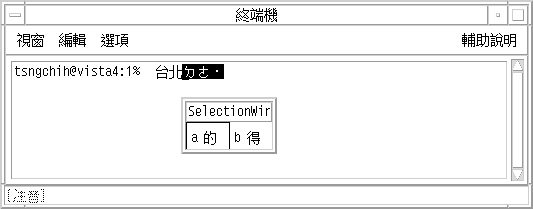Installing a Terminal
If you have not added a terminal to your system, install the terminal in ASCII mode only.
How to Add Terminals Through the Serial Port Interface
You can use the serial ports option from the Admintool menu to configure the serial ports for terminals. Serial ports provide the easiest means to install a terminal.
Note –
A Chinese terminal that supports CNS 11643 is installed as you would install an ASCII terminal.
-
Become superuser.
system% su
-
Type admintool.
The admintool menu will appear.
system# admintool
-
Select the Serial Ports icon.
-
Select Edit on the Serial Ports menu.
Modify Service submenu appears.
-
On the Modify Service submenu, select Enabled, Baud Rate 9600, and provide the terminal type.

-
Under Expert Options, select Create utemp entry and enter the appropriate module in the Streams Modules field.
Note –To install a terminal that supports BIG5 code for the Traditional Chinese Solaris Operating System, add big5euc to the Streams Modules field.

How to Add Terminals Through the Command Line
The following procedure is required to set up a terminal on ttya port through the command line.
-
Determine the port monitor version number by typing the following command:
# ttyadm -V
The port monitor version number displays.
-
Type the following commands, substituting the port monitor version number for ver.
# pmadm -r -p zsmon -s ttya # sacadm -a -p zsmon -t ttymon -c /usr/lib/saf/ttymon -v ver
For more information, see the pmadm(1M) and sacadm(1M) man pages.
-
To add a login service, use the pmadm command that matches your terminal type.
-
For EUC terminals, use the following command.
#pmadm -a -p zsmon -s ttya -i root -fu -v ver -m “ `ttyadm -S y \ -T terminal_type -d /dev/ttya -l 9600 -m ldterm,ttcompat -s \ /usr/bin/login`”
-
For BIG5 code terminals, use the STREAMS module big5euc in the ttyadm command.
# pmadm -a -p zsmon -s ttya -i root -fu -v ver -m “`ttyadm -S y \ -T terminal_type -d /dev/ttya -l 9600 -m big5euc,ldterm,ttcompat -s \ /usr/bin/login`”
-
-
Turn on the terminal.
Familiarize yourself with the documentation that accompanies the terminal.
-
Log in to the terminal.
-
Check to see that the installation is correct.
# setenv LANG locale # /bin/stty cs8 -istrip defeucw
Note –These values show that the operating system is set to communicate with the terminal in 8-bit no-parity mode. Make sure the terminal is set up in 8-bit no-parity mode. Refer to the terminal's setup manual for the proper way to set terminal options.
Setting a User's TTY
Do the following to verify that your TTY is set up properly.
-
Type the /bin/stty command with the -a option.
system% /bin/stty -a
-
If the cs8, -istrip values are not listed, use the following command to set them.
system% /bin/stty cs8 -istrip defeucw
This is the last step in setting up a terminal.
How to Use a BIG5 TTY With an EUC Locale
- © 2010, Oracle Corporation and/or its affiliates
